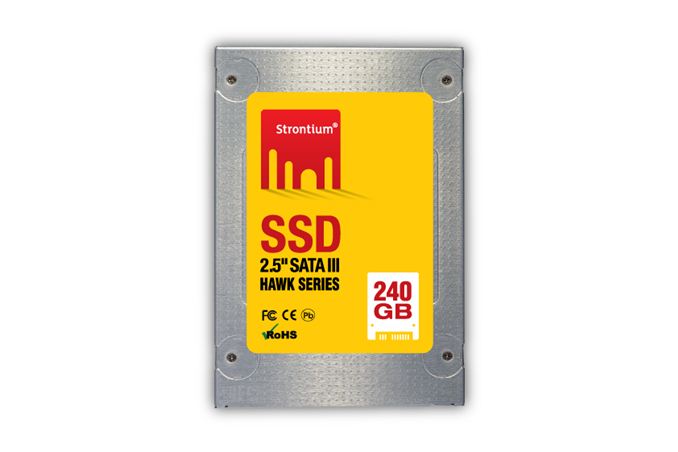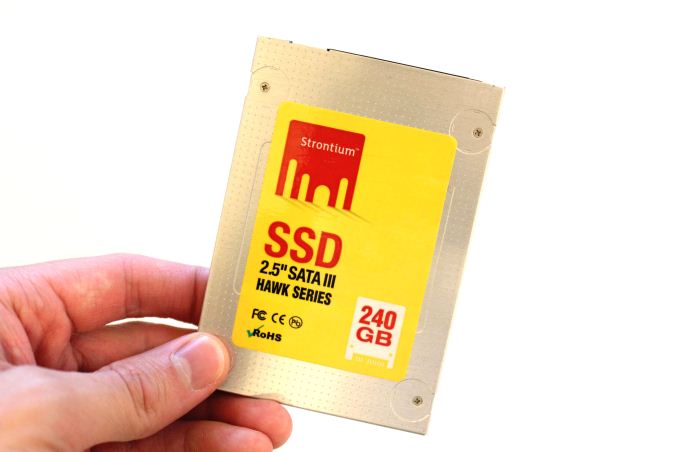Strontium Hawk (240GB) Review
by Kristian Vättö on June 25, 2013 8:00 AM EST
Strontium is probably a new acquaintance for many of our readers, but their story may be familiar. Founded in 2002 in Singapore, Strontium is one of the many memory manufacturers who have turned to SSDs to expand their product portfolio and increase revenues. Dozens of companies that have done the same: OCZ, Kingston, Mushkin, Crucial/Micron, ADATA, and Corsair to name a few. It's logical because the same companies that manufacture DRAM often make NAND too, so the contacts and channels are already in place. When you add the fact that all the controller/firmware technology can be licensed from SandForce (or Marvell if you're willing to invest in firmware), you don't actually need much in-house engineering to build an SSD.
What makes Strontium special is the fact that they actually buy the whole SSD from a third party and simply rebrand it. In case of the Hawk, Strontium sources the SSD from Toshiba, although they've at least had SK Hynix as their supplier as well in the past. Now, this isn't anything unheard of; readers who have followed the SSD scene for longer may remember Kingston's SSDNow M series SSDs, which was a rebranded Intel X25-M G2. However, to date I've not come by a company whose business model relies completely on rebranding SSDs. Strontium told me that after long-term evaluation they decided to go with a proven, high-quality product and focus their resources on other aspects such as validation and marketing. Strontium didn't go into detail about their validation methods but they told me that they verify that the products they ship perform to the spec provided by the actual manufacturer (including reliability tests).
There's even the original Toshiba sticker on the back of the drive
Due to Strontium's headquarters location, their main market is still in Asia. Strontium does have an office in the US but unfortunately none of the bigger retailers stock their SSDs currently. They do have their own online store that ships to US, though.
| Strontium Hawk Specifications | |
| Capacities | 120GB & 240GB |
| Controller | Toshiba TC58NC5HA9GST |
| NAND | Toshiba 19nm Toggle-Mode 2.0 MLC |
| Sequential Read | Up to 534MB/s |
| Sequential Write | Up to 482MB/s |
| 4KB Random Read | Up to 90K IOPS |
| 4KB Random Write | Up to 35K IOPS |
| Warranty | Three years |
The Hawk is available in capacities of 120GB and 240GB but as you can see in the Toshiba sticker above, the drive is actually 256GB. What's weird is that the drive also shows up as a 256GB drive (or 238.5GiB as it's displayed in Windows). At first I thought there was a problem with my sample as Strontium had switched suppliers (I'll get to this soon), but Strontium told me that they advertise the drive based on the capacity available to the end-user. In other words, Strontium markets it as 240GB because it shows up as a 238.5GiB drive in Windows due to the difference between Giga and Gibibyte. I wouldn't have a problem if it was Intel or some other major SSD OEM doing this as they could change the way GB is defined in the storage industry, but I don't see the point for a small-ish company like Strontium to do that. The only thing they will do is confuse buyers because everyone else is defining GB as 1000^3 bytes.
The other thing I'm not happy about is that Strontium changed the supplier earlier this year but kept the product name the same. It's normal for SSD OEMs to use multiple NAND suppliers and that's fine, but Strontium changed the whole SSD including the controller. The original Hawk was manufactured by SK Hynix and it was based on SandForce's SF-2281 controller and 26nm Hynix NAND (see e.g. Strontium's PR and Legit Reviews' review). My sample, on the other hand, is made by Toshiba and it has a Toshiba-Marvell controller coupled with 19nm Toshiba NAND.
Such a radical change should definitely require a change in the series name too since we are dealing with two very different SSDs. Strontium even has another SSD series called Python that uses an SF-2281 controller, so I fail to see why Strontium didn't for example name the Toshiba drive as Python and keep Hawk for the SF-2281 based drive. As far as I know, we are the first site to review the new version of the Hawk, meaning that potential buyers have had no idea that their drive might not be SF-2281 based like all the reviews are claiming. But let's see how the numbers line up first.












26 Comments
View All Comments
ssj3gohan - Wednesday, June 26, 2013 - link
Wait, what?! HIPM and DIPM have been standard features that are always enabled on every intel desktop system since the intel 5 series at least (and AM2+ on the AMD side, which had other reasons). The only reason not to have HIPM and DIPM is your choice of OS. It's a driver-enabled feature, it doesn't work without explicitly enabling it.Kristian Vättö - Wednesday, June 26, 2013 - link
That's not true. You can do the registry hack and get the option to enable HIPM+DIPM but that will have zero impact on power consumption on a desktop system. We've tried four different motherboards including Intel-branded ones and also both Windows 7 and 8 without success. That's why it took us so long to start doing HIPM+DIPM tests as Anand had to take an Ultrabook apart just for power testing and obviously I don't have access to that system due to geographical issues.JDG1980 - Tuesday, June 25, 2013 - link
If you want a Toshiba drive, why not just buy a Toshiba drive instead of one rebranded by a no-name company? I don't see the point of this.JarredWalton - Tuesday, June 25, 2013 - link
It's cheaper and uses the same hardware and firmware?Kristian Vättö - Tuesday, June 25, 2013 - link
Toshiba has quite poor retail presence, so Strontium may be targeting the markets where the availability of Toshiba SSDs is either very poor or non-existent.HisDivineOrder - Tuesday, June 25, 2013 - link
My concern would be what happens when they change products and firmwares are... nonexistent. SSD's are still far too temperamental to trust just some nobody who likes to throw caution to the wind.OCZ can't even be trusted in this regard.
Samsung, Intel, Micron/Crucial, maaaaybe Sandisk.
bji - Tuesday, June 25, 2013 - link
Can OCZ be trusted in *any* regard?zanon - Tuesday, June 25, 2013 - link
Kristian no they couldn't, seriously what the hell? We *still* have people arguing wrongly in freaking 2013? "Giga" is an SI prefix, it's base-10. That's what it is, anything else is wrong. This is particularly surprisingly from a technology enthusiast, as tech depends on precision, not random overloaded definitions. Maybe you'd like to suggest that they come up with their own definitions of "kilogram" and "pound" too with whatever mass they feel like? That sounds like a recipe for success!
If they want to show base-2, then they can use KiB/MiB/GiB/TiB/PiB. I don't think those sound the greatest but whatever, they're precise, correct, and the international standard (IEC 60027, published in *1999*). Storage makers were never wrong to use the SI prefixes and have base-10 numbers of sectors.
If anything the problem is Microsoft, who should long since have switched to displaying GB instead of GiB. Even Apple finally updated ages ago.
Kristian Vättö - Tuesday, June 25, 2013 - link
The problem is that Giga is not only an SI prefix, it's also a JEDEC prefix where Giga is defined as 1024^3. I do agree that Giga should only be used as an SI prefix (i.e. meaning 1000^3) but I guess someone at JEDEC thought that since 1000^3 and 1024^3 are "close enough", lets just call them the same.I also agree that it's Microsoft who should just change to the SI standard and define GB as 1000^3 bytes like Apple did. My point about Intel was that it's useless for a small OEM like Strontium to differ from the norm and I don't see Intel or anyone else switching away from the SI standard because the advertised capacities would end up being smaller than they are now.
KAlmquist - Wednesday, June 26, 2013 - link
"Storage makers were never wrong to use the SI prefixes"This is, I believe, inconsistent with your preceding paragraph. When disk drive manufacturers came up with their own definition of megabyte to make their disk drives seem larger, that created the same problems you envision if someone came up with their own definitions for "kilogram" and "pound".
As you note, that the IEC has decided to endorse the disk drive manufacture's definition of "megabyte" and has invented the term "mebibyte" to refer to a megabyte. That's a response to the linguistic mess created by the disk drive manufacturers; it doesn't justify creating the mess in the first place.
Meanwhile, as Kristian notes, JEDEC is sticking with the original meaning of the word. Words can acquire new meanings fairly quickly, but it takes a long time (on the order of 100 years) for a word to lose a well-established meaning.